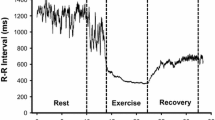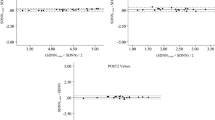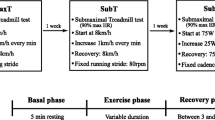Abstract
Previous studies have neglected the first recovery minutes after exercise when studying post-exercise heart rate variability (HRV). The present aim was to evaluate autonomic HR control immediately after exercise using Short-time Fourier transform (STFT) and to compare the effects of low [LI, 29(6)% of maximal power] and high [HI, 61(6)% of maximal power] intensity bicycle exercise on the HRV recovery dynamics. Minute-by-minute values for low (LFPln, 0.04–0.15 Hz) and high (HFPln, 0.15–1.0 Hz) frequency power were computed from R-R interval data recorded from 26 healthy subjects during 10 min recovery period after LI and HI. The HRV at the end of exercise and recovery was assessed with Fast Fourier transform as well. The results showed that LFPln and HFPln during the recovery period were affected by exercise intensity, recovery time and their interaction (P < 0.001). HFPln increased during the first recovery minute after LI and through the second recovery minute after HI (P < 0.001). HFPln was higher for LI than HI at the end of the recovery period [6.35 (1.11) vs. 5.12 (1.01) ln (ms2), P < 0.001]. LFPln showed parallel results with HFPln during the recovery period. In conclusion, the present results obtained by the STFT method, suggested that fast vagal reactivation occurs after the end of exercise and restoration of autonomic HR control is slower after exercise with greater metabolic demand.



Similar content being viewed by others
Notes
Constant 1 was added to the absolute power value (x) and a natural log transformation of their sum was then calculated, y = ln (1 + x).
References
Akselrod S, Gordon D, Madwed JB, Snidman NC, Shannon DC, Cohen RJ (1985) Hemodynamic regulation: investigation by spectral analysis. Am J Physiol Heart Circ Physiol 249:H867–H875
Arai Y, Saul JP, Albrecht P, Hartley LH, Lilly LS, Cohen RJ, Colucci WS (1989) Modulation of cardiac autonomic activity during and immediately after exercise. Am J Physiol Heart Circ Physiol 256: H132–H141
Bernardi L, Salvucci F, Suardi R, Solda PL, Calciati A, Perlini S, Falcone C, Ricciardi L (1990) Evidence for an intrinsic mechanism regulating heart rate variability in the transplanted and the intact heart during submaximal dynamic exercise? Cardiovasc Res 24:969–981
Casadei B, Cochrane S, Johnston J, Conway J, Sleight P (1995) Pitfalls in the interpretation of spectral analysis of the heart rate variability during exercise in humans. Acta Physiol Scand 153:125–131
Cole C, Foody J, Blackstone E, Lauer M (2000) Heart rate recovery after submaximal exercise testing as a predictor of mortality in a cardiovascularly healthy cohort. Ann Intern Med 132:552–555
Cottin F, Médigue C, Leprêtre PM, Papelier Y, Koralsztein JP, Billat V (2004) Heart rate variability during exercise performed below and above ventilatory threshold. Med Sci Sports Exerc 36:594–6000
Cottin F, Leprêtre PM, Lopes P, Papelier Y, Médigue C, Billat V (2006) Assessment of ventilatory thresholds from heart rate variability in well-trained subjects during cycling. Int J Sports med 27:959–967
Eckberg DL (2000) Physiological basis for human autonomic rhythms. Ann Med 32:341–349
Goldberger JJ, Le FK, Lahiri M, Kannankeril PJ, Ng J, Kadish AH (2006) Assessment of parasympathetic reactivation after exercise. Am J Physiol Heart Circ Physiol 290: H2446–H2452
Hatfield BD, Spalding TW, Santa Maria DL, Porges SW, Potts JT, Byrne EA, Brody EB, Mahon AD (1998) Respiratory sinus arrhythmia during exercise in aerobically trained and untrained men. Med Sci Sports Exerc 30:206–214
Imai K Sato H, Hori M, Kusuoka H, Ozaki H, Ykoyama H, Takeda H, Inoue M, Kamada T (1994) Vagally mediated heart rate recovery after exercise in accelerated in athletes but blunted in patients with chronic heart failure. J Am Coll Cardiol 24:1529–1535
Kaikkonen P, Nummela A, Rusko H (2007a) Heart rate variability dynamics during early recovery after different endurance exercises. Eur J Appl Physiol (accepted for publication)
Kaikkonen P, Rusko H, Martinmäki K (2007b) Post-exercise heart rate variability of endurance athletes after different high-intensity exercises. Scand J Med Sci Sports (accepted for publication)
Mainardi LT, Bianchi AM, Cerutti S (2002) Time-frequency and time-varying analysis for assessing the dynamic responses of cardiovascular control. Crit Rev Biomed Eng 30(1–3):175–217
Martinmäki K, Rusko H, Kooistra L, Kettunen J, Saalasti S (2006a) Intraindividual validation of heart rate variability indexes to measure vagal effects on hearts. Am J Physiol Heart Circ Physiol 290:H640–H647
Martinmäki K, Rusko H, Saalasti S, Kettunen J (2006b) Ability of short-time Fourier transform method to detect transient changes in vagal effects on hearts: a pharmacological blocking study. Am J Physiol Heart Circ Physiol 290:H2582–H2589
Nishime E, Cole C, Blackstone E, Pashkow F, Lauer M (2000) Heart rate recovery and treadmill exercise score as predictors of mortality in patients referred for exercise ECG. JAMA 284:1392–1398
O’Leary D (1996) Heart rate control during exercise by baroreceptors and skeletal muscle afferents. Med Sci Sports Exerc 28:210–217
Oppenheim A, Schafer RW (1999) Discrete-time signal processing. Prentice Hall, Upper Saddle River
Orizio C, Perini R, Comandè A, Castellano M, Beschi M, Veicsteinas A (1998) Plasma catecholamines and heart rate at the beginning of muscular exercise in man. Eur J Appl Physiol 57:644–651
Pagani M, Lombardi F, Guzzetti S, Rimoldi O, Furlan R, Pizzinelli P, Sandrone G, Malfatto G, Dell’Orto S, Piccaluga E, Turiel M, Baselli G, Gerutti S, Malliani A (1986) Power spectral analysis of heart rate and arterial pressure variabilities as a marker of sympathovagal interaction in man and conscious dogs. Circ Res 59:178–193
Perini R, Orizio C, Comande A, Castellano M, Beschi M, Veicsteinas A (1989) Plasma norepinephrine and heart rate dynamics during recovery from submaximal exercise in man. Eur J App Physiol Occup Physiol 58:879–883
Perini R, Orizio C, Baselli G, Gerutti S, Veicsteinas A (1990) The influence of exercise intensity on the power spectrum of heart rate variability. Eur J Appl Physiol 61:143–148
Perini R, Milesi S, Fisher NM, Pendergast DR, Veicsteinas A (2000) Heart rate variability during dynamic exercise in elderly males and females. Eur J Appl Physiol 82:8–15
Pichon AP, de Bisschop C, Roulaud A, Papelier Y (2004) Spectral analysis of heart rate variability during exercise in trained subjects. Med Sci Sports Exerc 36:1702–1708
Pierpont GL, Voth EJ (2004) Assessing autonomic function by analysis of heart rate recovery from exercise in healthy subjects. Am J Cardiol 94:64–68
Pierpont GL, Stolpman DR, Gornick CC (2000) Heart rate recovery post-exercise as an index of parasympathetic activity. J Auton Nerv Syst 80:169–74
Robinson BF, Epstein SE, Beiser GD, Braunwald E (1966) Control of heart rate by the autonomic nervous system. Studies in man on the interrelation between baroreceptor mechanisms and exercise. Circ Res 19:400–411
Rowell LB (1986) Human circulation regulation during physical stress. Oxford University Press, New York, pp. 213–256
Savin W, Davidson D, Haskell W (1982) Autonomic contribution to heart rate recovery from exercise in humans. J Appl Physiol 53:1572–1575
Task Force of the European Society of Cardiology, the North American Society of Pacing and Electrophysiology (1996) Heart rate variability. Standard of measurement, physiological interpretation and clinical use. Circulation 93:1046–1065
Taylor HL, Buskirk ER, Henschel HA (1955) Maximal oxygen intake as an objective measure of cardio-respiratory performance. J Appl Physiol 8:73–80
Terziotti P, Schena F, Gulli G (2001) Post-exercise recovery of autonomic cardiovascular control: a study by spectrum and cross-spectrum analysis in humans. Eur J Appl Physiol 84:187–194
Warren JH, Jaffe RS, Wraa CE, Stebbins CL (1997) Effect of autonomic blockade onpower spectrum of heart rate variability during exercise. Am J Physiol 273:R495–R502
Acknowledgments
This study was funded by grants from the Ministry of Education, Finland, and from TEKES-National Technology Agency of Finland. The authors thank Ph.D. Sami Saalasti for his help in performing the heart rate variability analyses. This study was partly funded by a grant from Sunto Ltd, Finland and Firstbeat Technologies Ltd, Finland. Heikki Rusko is currently stockowner of Firstbeat Technologies Ltd, Finland.
Author information
Authors and Affiliations
Corresponding author
Additional information
An erratum to this article is available at http://dx.doi.org/10.1007/s00421-008-0687-9.
Rights and permissions
About this article
Cite this article
Martinmäki, K., Rusko, H. Time-frequency analysis of heart rate variability during immediate recovery from low and high intensity exercise. Eur J Appl Physiol 102, 353–360 (2008). https://doi.org/10.1007/s00421-007-0594-5
Accepted:
Published:
Issue Date:
DOI: https://doi.org/10.1007/s00421-007-0594-5




